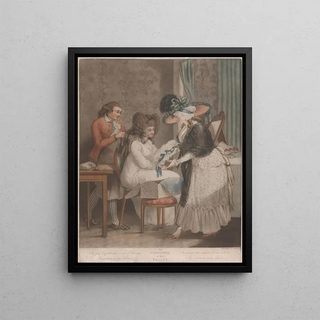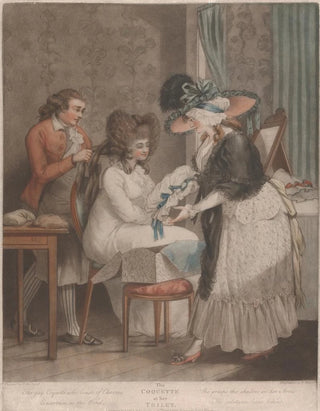Art print | La Coquette à sa toilette - George Morland


View from behind

Frame (optional)
In the vibrant world of 18th-century British art, George Morland stands out for his ability to capture the very essence of everyday life. Among his iconic works, "La Coquette à sa toilette" emerges as an ode to beauty and femininity. This painting, imbued with delicacy and sensitivity, invites viewers to delve into the intimacy of a woman in the midst of preparation, revealing the subtleties of her inner world. The scene, both simple and evocative, transports the observer to a time when fashion and refinement played a central role in society.
Style and uniqueness of the artwork
"La Coquette à sa toilette" is distinguished by its characteristic style, blending realism and romanticism. Morland, a true master of light, skillfully plays with shadows and reflections, creating an intimate atmosphere. The color palette, soft and nuanced, enhances the delicacy of the protagonist's features, while the meticulous details of her environment—from mirrors to beauty accessories—testify to a particular attention to the depiction of daily life. Every element of the composition seems to tell a story, inviting the viewer to ponder the thoughts and emotions of the woman portrayed. This ability to evoke deep feelings through ordinary scenes makes Morland a unique artist, capable of transcending the banal to create a work of art.
The artist and his influence
George Morland, born in 1763, is often recognized for his contribution to the artistic scene of his time. Influenced by masters of the past, he developed a style that is uniquely his own, combining modern sensitivity with classical techniques. His work is marked by an exploration of themes related to domestic life, nature, and the morals of his era. Morland was also a pioneer in the representation of women, endowing them with a human and complex dimension, far from the stereotypes of the period. His influence is felt among many artists who succeeded him, seeking to capture the fleeting beauty of everyday moments with the same emotional intensity.
An exceptional wall decoration signed Artem Legrand
In the

Matte finish

View from behind

Frame (optional)
In the vibrant world of 18th-century British art, George Morland stands out for his ability to capture the very essence of everyday life. Among his iconic works, "La Coquette à sa toilette" emerges as an ode to beauty and femininity. This painting, imbued with delicacy and sensitivity, invites viewers to delve into the intimacy of a woman in the midst of preparation, revealing the subtleties of her inner world. The scene, both simple and evocative, transports the observer to a time when fashion and refinement played a central role in society.
Style and uniqueness of the artwork
"La Coquette à sa toilette" is distinguished by its characteristic style, blending realism and romanticism. Morland, a true master of light, skillfully plays with shadows and reflections, creating an intimate atmosphere. The color palette, soft and nuanced, enhances the delicacy of the protagonist's features, while the meticulous details of her environment—from mirrors to beauty accessories—testify to a particular attention to the depiction of daily life. Every element of the composition seems to tell a story, inviting the viewer to ponder the thoughts and emotions of the woman portrayed. This ability to evoke deep feelings through ordinary scenes makes Morland a unique artist, capable of transcending the banal to create a work of art.
The artist and his influence
George Morland, born in 1763, is often recognized for his contribution to the artistic scene of his time. Influenced by masters of the past, he developed a style that is uniquely his own, combining modern sensitivity with classical techniques. His work is marked by an exploration of themes related to domestic life, nature, and the morals of his era. Morland was also a pioneer in the representation of women, endowing them with a human and complex dimension, far from the stereotypes of the period. His influence is felt among many artists who succeeded him, seeking to capture the fleeting beauty of everyday moments with the same emotional intensity.
An exceptional wall decoration signed Artem Legrand
In the






